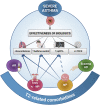Association Between T2-related Comorbidities and Effectiveness of Biologics in Severe Asthma.
Wechsler ME, Scelo G, Larenas-Linnemann DES, Torres-Duque CA, Maspero J, Tran TN, Murray RB, Martin N, Menzies-Gow AN, Hew M, Peters MJ, Gibson PG, Christoff GC, Popov TA, Côté A, Bergeron C, Dorscheid D, FitzGerald JM, Chapman KR, Boulet LP, Bhutani M, Sadatsafavi M, Jiménez-Maldonado L, Duran-Silva M, Rodriguez B, Celis-Preciado CA, Cano-Rosales DJ, Solarte I, Fernandez-Sanchez MJ, Parada-Tovar P, von Bülow A, Bjerrum AS, Ulrik CS, Assing KD, Rasmussen LM, Hansen S, Altraja A, Bourdin A, Taille C, Charriot J, Roche N, Papaioannou AI, Kostikas K, Papadopoulos NG, Salvi S, Long D, Mitchell PD, Costello R, Sirena C, Cardini C, Heffler E, Puggioni F, Canonica GW, Guida G, Iwanaga T, Al-Ahmad M, García U, Kuna P, Fonseca JA, Al-Lehebi R, Koh MS, Rhee CK, Cosio BG, Perez de Llano L, Perng DS, Huang EW, Wang HC, Tsai MJ, Mahboub B, Salameh LIJ, Jackson DJ, Busby J, Heaney LG, Pfeffer PE, Goddard AG, Wang E, Hoyte FCL, Chapman NM, Katial R, Carter V, Bulathsinhala L, Eleangovan N, Ariti C, Lyu J, Porsbjerg C, Price DB.
Wechsler ME, et al.
Am J Respir Crit Care Med. 2024 Feb 1;209(3):262-272. doi: 10.1164/rccm.202305-0808OC.
Am J Respir Crit Care Med. 2024.
PMID: 38016003


